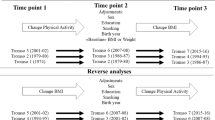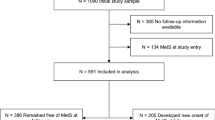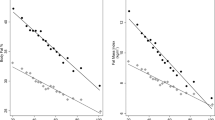Abstract
OBJECTIVE: To determine whether habitual leisure time physical activity and body mass change of working-aged men and women are associated. DESIGN: Prospective 10 y follow-up study. SUBJECTS: A regionally representative cohort of 19–63 y old men (n=2564) and women (n=2695) in three municipalities in Finland. MEASUREMENTS: The main outcome measures were average body mass change during the 10 y of follow-up and the clinically significant body mass gain defined as a body mass gain of 5 kg or more during the follow-up and a body mass index of 26 or higher at the end of the follow-up. Leisure time physical activity was determined from self-administered questionnaires. RESULTS: After adjustment for the potential confounders, the logistic regression analysis showed that the men and women with no regular weekly activity at the end of the follow-up had an odds ratio of 2.59 (95% confidence interval, 1.69–3.97) and 2.67 (1.65–4.31), respectively for clinically significant body mass gain in comparison with the most active groups. The men who had decreased their activity during the 10 y follow-up had an odds ratio of 1.96 (1.39–2.75), and the men who were physically inactive all the time had an odds ratio of 1.62 (1.18–2.20) for clinically significant body mass gain when compared with the subjects who were active all the time. Among the women the odds ratios for clinically significant body mass gain after adjustment for potential confounders were 2.49 (1.72–3.60) and 1.61 (1.17–2.21), respectively. CONCLUSION: These findings are consistent with the hypothesis that regular physical activity prevents body mass gain and physical inactivity is a risk factor for body mass gain and obesity among adults.
This is a preview of subscription content, access via your institution
Access options
Subscribe to this journal
Receive 12 print issues and online access
$259.00 per year
only $21.58 per issue
Buy this article
- Purchase on Springer Link
- Instant access to full article PDF
Prices may be subject to local taxes which are calculated during checkout
Similar content being viewed by others
Author information
Authors and Affiliations
Rights and permissions
About this article
Cite this article
Haapanen, N., Miilunpalo, S., Pasanen, M. et al. Association between leisure time physical activity and 10-year body mass change among working-aged men and women. Int J Obes 21, 288–296 (1997). https://doi.org/10.1038/sj.ijo.0800403
Received:
Revised:
Accepted:
Issue Date:
DOI: https://doi.org/10.1038/sj.ijo.0800403
Keywords
This article is cited by
-
The impact of sitting time and physical activity on major depressive disorder in South Korean adults: a cross-sectional study
BMC Psychiatry (2017)
-
No seasonal variation in physical activity of Han Chinese living in Beijing
International Journal of Behavioral Nutrition and Physical Activity (2017)
-
The Perceived and Actual Physical Activity Behaviors of African American Women
Journal of Community Health (2016)
-
Hyperhomocysteinaemia as a potential marker of early renal function decline in middle-aged Asian people without chronic kidney disease
International Urology and Nephrology (2016)
-
Income adequacy and education associated with the prevalence of obesity in rural Saskatchewan, Canada
BMC Public Health (2015)



